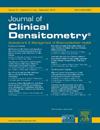Toe Grip Strength is Another Indicator of Muscle Strength and Bone Mass in Older Men
IF 1.6
4区 医学
Q4 ENDOCRINOLOGY & METABOLISM
引用次数: 0
Abstract
Toe grip strength (TGS) measures foot muscle strength and evaluates stability maintenance, as well as the risk of falls. Handgrip strength (HGS) is considered a simple and effective method for assessing overall strength, and it correlates with bone variables. The aim of this study was: first, to investigate the relationship between TGS and overall strength and bone variables; and second, to compare the relationships between TGS and HGS with overall strength and bone variables. This cross-sectional study included 59 Caucasian men aged 60 to 84 years. Participants underwent muscle strength testing using exercises such as the bench press, leg extension, leg curl, and biceps curl, along with assessments of HGS and TGS. Body composition and bone mineral density (BMD) were assessed using dual-energy X-ray absorptiometry (DXA). TGS was positively correlated with bench press performance (r = 0.68; p < 0.001), leg extension strength (r = 0.72; p < 0.001), leg curl strength (r = 0.83; p < 0.001), and biceps curl strength (r = 0.74; p < 0.001). A strong positive correlation was also observed between TGS and HGS (r = 0.88; p < 0.001). Finally, both TGS and HGS showed significant positive correlations with bone mass (r = 0.62; p < 0.001 and r = 0.68; p < 0.001, for toe grip and handgrip respectively). In conclusion, this study suggests that TGS is as good as HGS as a positive determinant of muscle strength and bone mass in older men.
脚趾握力是老年男性肌肉力量和骨量的另一个指标
脚趾握力(TGS)测量足部肌肉力量,评估稳定性维持,以及跌倒的风险。握力(HGS)被认为是评估整体力量的一种简单有效的方法,它与骨骼变量相关。本研究的目的是:首先,探讨TGS与整体强度和骨骼变量之间的关系;第二,比较TGS和HGS与整体强度和骨骼变量之间的关系。这项横断面研究包括59名年龄在60至84岁之间的高加索男性。参与者通过卧推、腿部伸展、腿部弯曲和肱二头肌弯曲等锻炼进行肌肉力量测试,同时评估HGS和TGS。采用双能x线吸收仪(DXA)评估体成分和骨密度(BMD)。TGS与卧推性能呈正相关(r = 0.68;P <; 0.001),腿部伸展力量(r = 0.72;P <; 0.001),腿屈强度(r = 0.83;P <; 0.001),二头肌弯曲强度(r = 0.74;p & lt; 0.001)。TGS与HGS之间也存在显著正相关(r = 0.88;p & lt; 0.001)。最后,TGS和HGS与骨量呈显著正相关(r = 0.62;P <; 0.001,r = 0.68;P <; 0.001,分别为趾握和手握)。总之,这项研究表明,TGS和HGS一样,是老年男性肌肉力量和骨量的积极决定因素。
本文章由计算机程序翻译,如有差异,请以英文原文为准。
求助全文
约1分钟内获得全文
求助全文
来源期刊

Journal of Clinical Densitometry
医学-内分泌学与代谢
CiteScore
4.90
自引率
8.00%
发文量
92
审稿时长
90 days
期刊介绍:
The Journal is committed to serving ISCD''s mission - the education of heterogenous physician specialties and technologists who are involved in the clinical assessment of skeletal health. The focus of JCD is bone mass measurement, including epidemiology of bone mass, how drugs and diseases alter bone mass, new techniques and quality assurance in bone mass imaging technologies, and bone mass health/economics.
Combining high quality research and review articles with sound, practice-oriented advice, JCD meets the diverse diagnostic and management needs of radiologists, endocrinologists, nephrologists, rheumatologists, gynecologists, family physicians, internists, and technologists whose patients require diagnostic clinical densitometry for therapeutic management.
 求助内容:
求助内容: 应助结果提醒方式:
应助结果提醒方式:


